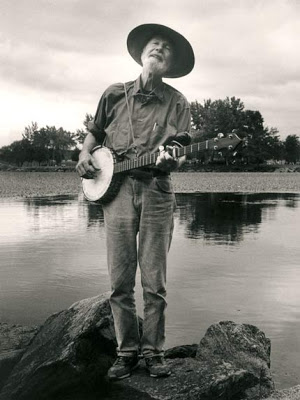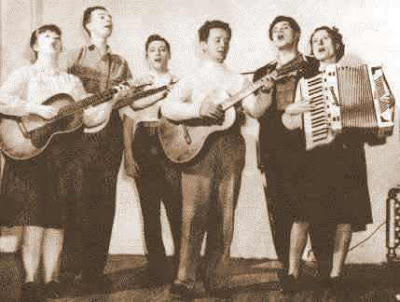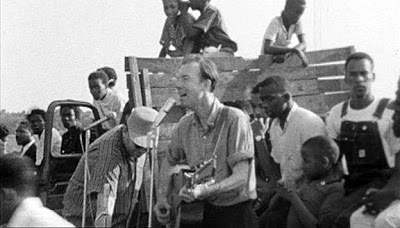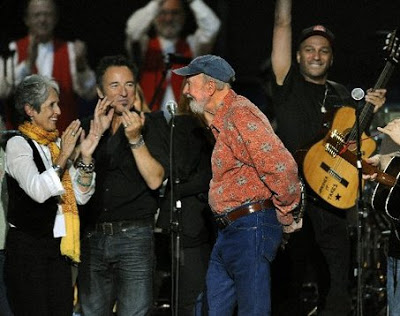
Celebrating Pete Seeger:
Our political troubador
More than any other individual, he had conceived and fostered a tradition of protest song that drew from a number of cultural roots, had significant political consequence, and reshaped the forms and content of popular music.
By Dick Flacks
[This article also appears in the Autumn issue of Jewish Currents. A longer version was published on Truthdig.]
Pete Seeger turned 90 on May 3rd, providing the occasion for a huge celebratory concert in Madison Square Garden featuring a wide array of popular musicians. In the two years prior, Pete got more mainstream attention than he’d received in the previous seventy years.
Bruce Springsteen toured internationally with a large band playing material from Pete’s folksong repertory. There was a documentary film in theaters and on public television, Pete Seeger: The Power of Song. Two new biographies are in the stores (“To Everything There Is a Season”: Pete Seeger and the Power of Song, by Allan Winkler, and The Protest Singer: An Intimate Portrait of Pete Seeger, by Alec Wilkinson), and David King Dunaway’s earlier work, “How Can I Keep From Singing”: The Ballad of Pete Seeger, has been updated and republished.
There’s even an ongoing campaign to get Seeger nominated for the Nobel Peace Prize.
The attention he is now getting is certainly deserved, given his life story and his influence on American music. One feature of that story, however, is that he is one of the least-known famous people in America. I use protest music a lot in my teaching about social movements, and over the years I’ve found that fewer than five percent of my students can identify him. Even with the attention he’s received in recent years, he remains paradoxically shadowy, given his political and cultural influence.
This paradox goes to the heart of what his life project has been. One obvious reason for Seeger’s marginalization has been his commitment to the political left.
His father, noted composer and musicologist Charles Seeger, was an important leader of the cultural front fostered by the Communist Party during the 1930s. Charles helped form a composers’ collective that sought to create a new music for revolutionary workers and to preserve and reinvigorate folk and vernacular musics as an alternative to commodified mass culture (its members included Marc Blitzstein, Aaron Copland and other young radical musicians).
So Pete grew up immersed in the left. He joined the Young Communist League during his brief time at Harvard, and was a Communist Party member (according to his biographers) during most of the 1940s. Although he dropped formal membership in the CP in the late 1940s, he was one of the star cultural figures of the communist-oriented left for many years after.
Teenagers like me and my wife (both red-diaper babies) were proud that Pete was “ours,” appearing at the benefits, hootenannies, summer camps and rallies that defined much of our cultural lives during the 1950s, when kids of our background felt pretty isolated from the political and cultural mainstream. His allegiances made him the prototype of the blacklisted entertainer — and it was the blacklist that excluded him from television and blanked him out of the awareness of mainstream America.
That exclusion did not derail Pete’s life project. On the contrary, it compelled him to fulfill that project rather than succumb to temptations or demands that might have come from more conventional commercial success. I want here to spell out what that project was, and how it affected history.
Alec Wilkinson’s new biography defines Seeger as the epitome of the rugged individualist. We see him in very old age, living in a house he built on the banks of the Hudson River. He, his wife Toshi, and their small children moved there in the 1940s, and their lives were indeed rugged — without electricity and running water for a while, they chopped wood and grew food in a clearing in the forest.
Near the end of the book, we see Seeger and members of his clan collecting sap and making maple syrup. Wilkinson appreciates the paradox that this man, long reviled as a communist, has tried to live the American ideal of the self-made, self-sufficient man.
But Seeger was a Communist, and continues to describe himself as a “communist with a small c.” He was raised by his father to see music as a group activity, dependent on the people’s participation, more than as a realm of individual accomplishment dependent on the virtuosity of a few.
“Vernacular” music, said Charles Seeger, is the foundation from which all other musics derive, and music, in turn, should aid in inspiring people “into more independent, capable, and democratic action.” We can read in these lines the principled foundation for Pete Seeger’s seventy years as an artist and political being. They are a primary source for the life project he began to formulate and implement when he was in his early 20s.
I use the word “project” instead of “career” because Seeger himself resisted talking about his “career.” From the outset, he sought to channel his ambition toward social and cultural change and to exorcise his strivings for personal recognition.
In the early 1940s, the Almanacs even performed anonymously (with Pete often using an assumed name), emulating various European artistic collectives of that time. A number of politically committed young musicians were part of the Almanacs collective, but Pete, in his early 20s, was the most disciplined — focused on keeping the group together and achieving its shared purpose, which was to create new songs, rooted in vernacular music, with lyrics that might mobilize political action.
The Almanacs’ most lasting songs were those like Woody Guthrie’s “Union Maid” that became anthems of the CIO organizing campaigns or spurred anti-Nazi sentiment to support the war effort (“The Sinking of the Reuben James”).
In the entertainment world, there was something new and attractively fresh about the fusion of folk music and contemporary topics. The middle-class Almanacs, especially Seeger, undoubtedly thought that their unprofessional style (they wore blue jeans or overalls, and their performances were deliberately unpolished) would help them forge connections to the working-class audiences they hoped to reach.
That assumption has often been mocked; workers were much more likely to want the polished performances of Tommy Dorsey, Bing Crosby or the Andrews Sisters. But the mockery misses the deeper aim of Seeger’s project, to make space for a popular music created not for the commercial market but for sustaining the “democratic action” envisioned by his father.
The Almanacs’ collective didn’t last long, in part because several members entered the military. While in uniform, Seeger continued his project, recording songs of the Spanish civil war and a number of other topical songs (accompanied by other emerging folksingers such as Burl Ives, Josh White, and Sonny Terry). He served in the Philippines as an entertainer for wounded GIs and learned quite a bit about how music can work to build collective morale. By war’s end, he was certain that making politically relevant music was his life’s work.
After the war, Seeger’s energies turned toward organizational entrepreneurship rather than merely performing. He sparked the formation of a national “People’s Artists” network of leftwing music-makers to serve as a booking agency, a publisher of song-filled newsletters and books, and a support framework for advancing a popular music relevant to political action.
In the immediate postwar period, leftists hoped that the dynamism of the 1930s labor movement would continue and that the social democratic logic of the New Deal would be followed by the post-FDR government. Seeger imagined that his people’s music network would be wedded to the unions and other social movements, providing fertile ground for growing a leftward popular culture.
But a profound split in the union movement on the “Communist” issue dashed such optimism, and the increasing tempo of the Red Scare thoroughly marginalized the network Seeger had worked so hard to build.
Still, his penchant for organizational entrepreneurship was an important dimension of his work that deserves more attention than any of his biographers provide. Seeger’s major successes have included the song magazines Sing Out! and Broadside, which published and publicized the politically conscious new songwriting of the 1960s; the Newport
Folk Festivals of the late ’50s and ’60s, which brought together a new generation of troubadours with a vast array of traditional performers; a book, originally mimeographed, How To Play the 5-String Banjo, which inspired tens of thousands to play this largely forgotten instrument; the formation of the Freedom Singers (Cordell Reagon, Bernice Johnson, Charles Neblett and Rutha Mae Harris), who toured (with Toshi as their agent) to raise awareness and money for the Student Nonviolent Coordinating Committee; and the Clearwater Sloop, which sparked the movement to clean up the Hudson River and became the center of an ongoing environmental education program.
None of these efforts was single-handedly created by Seeger, of course. In fact, his biographers suggest that he was not exactly a detail person. Toshi took on many of the managerial tasks his work required (while managing their household of three children in their log cabin). But Pete always had the ability to make the impossible seem plausible and thereby inspire and goad others to help fulfill his various organizational visions.
It’s a rare thing for an artist to be so aware of the need for institution-building, but Seeger saw from the start that cultural change is inextricably bound up with social organization.
His most promising mainstream venture was the effort by the Almanacs’ successor group, the Weavers, to work commercial venues. The quartet, born out of the People’s Artists cultural left, was discovered and signed by Gordon Jenkins of Decca, one of the largest record labels of the 1940s and ’50s. Jenkins produced a series of enormous hits with the Weavers, and they were booked into many of the leading club and concert venues. Rightwing entrepreneurs quickly went after them, however, largely based on Seeger’s long association with “Communist” politics, and only two years after they had burst on the scene, the Weavers’ commercial career was over.
Seeger quickly embarked on a perpetual tour of America’s college campuses, summer camps, and auditoriums, where he honed a solo performance style and repertory that defined him as a musician. In the process, he brought into being a ragtag army of young fans. His commitment to his project was embodied in his particular performance style: The goal was not to display his own talent, nor to thrill an audience, but to bring songs to people so that they could make them their own.
Every Seeger performance was centered on group singing. Simply getting a mass audience to join in requires skill, but he aimed further — to teach new songs, and to foster singing in harmony. He particularly relished teaching South African songs in their original language (most famously “Wimoweh”) with two or three competing melodic lines.
There is an empowering effect in the very sound of a singing assembly. There is a persuasive effect that can come when audience members sing lyrics expressing a political perspective or commitment. There is a sense of mutual validation when a crowd of people sing together in an attitude of resistance. And once you sing a song, there is a good chance that you will be able to reproduce it by and for yourself, with no need for the professional performer to evoke it.
By working as a song leader and teacher, Pete was achieving Charles Seeger’s wish for a mode of musical performance that had an ability to “aid in the welding of the people into more independent, capable, and democratic action.”
Pete Seeger’s blacklisting by network TV lasted at least fifteen years and made it impossible for him to have access to mass audiences in the U.S. Still, his cultural impact steadily increased during those years. When the Weavers reunited in an historic Carnegie Hall Christmas season concert in 1955 in defiance of the blacklist, the recording of this event on the upstart Vanguard label hit the charts, and the group continued to tour and record for several more years (although Seeger separated from it).
Seeger drew ever larger concert crowds, including many of the young who heard him first at summer camp or college campus. He recorded dozens of albums for Folkways in that period.
Meanwhile, a pop-centered folksong revival became commercially huge. The Weavers’ imitators, led by the Kingston Trio and, later, Peter, Paul and Mary, sold millions of records. The resulting commodification inevitably denatured and contradicted Seeger’s project.
His support of the Newport Folk Festivals helped provide alternative, more authentic access to rooted musics and performers. By the early 1960s, a musical rebellion against pop folk was in the works, as a band of young troubadours, consciously following in Woody and Pete’s footsteps, started singing. Bob Dylan, Joan Baez, Phil Ochs, Odetta and many others performed in new folk clubs, recorded on upstart labels, appeared at civil rights and ban-the-bomb rallies, and dominated the college tours.
The folk music revival became a political as well as cultural phenomenon. The festivals, concerts and clubs where folk fans congregated were among the prime social spaces for shaping awareness and engagement with the civil rights movement and the New Left.
Pete Seeger’s belief in the power of song derived in large part from the fact that a number of great social movements were fueled by music. There is a tradition of labor song in America, dating from the 19th century, and a number of songs from that tradition continue to this day to help define the identities of labor organizers and raise spirits on the picket line.
Seeger’s dream of a singing mass movement was much more fully realized, however, in the civil rights struggle. As marchers gathered in churches to prepare to challenge segregation with their very bodies, traditional songs and song styles used in African-American churches were turned into hymns of solidarity and shared risk-taking, with lyrics adapted for the occasion.
It was Seeger who had first made “We Shall Overcome” known to civil rights activists in the 1950s, and his concerts in the early ’60s taught the new freedom songs to mass audiences in the north. The music of the southern movement was an important factor in forging a moral identification with it among northern students — an identification that led to a flood of volunteers to southern organizing campaigns.
By his mid-40s, Pete Seeger could take satisfaction that his decision to organize his life around a principled project and disdain a “career” had changed history. More than any other individual, he had conceived and fostered a tradition of protest song that drew from a number of cultural roots, had significant political consequence, and reshaped the forms and content of popular music.
He had revived the social role of the troubadour — a special kind of intellectual, who, as Bruce Springsteen said at Madison Square Garden, pointed a dagger at the heart of Americans’ illusions about their history while telling their stories in song. But Seeger performed in ways that intended, and sometimes succeeded, in empowering audience members to sing their own songs and find capacities for democratic action through that singing.
If he’s often portrayed as a victim of blacklist and censorship, it is clear that his long marginalization from the mainstream was necessary for the fulfillment of his project. When he refused to discuss his political allegiances with the House Un-American Activities Committee in 1955 (basing his non-cooperation on his First Amendment rights rather than on the Fifth Amendment protection against self-incrimination), Seeger’s courageous stance led the committee to charge him with ten counts of contempt of Congress, each punishable by a year in jail.
Trial and appeal of these charges took seven years and reinforced his blacklisting. In the end, the Court of Appeals overturned his conviction. It was in many ways a costly time for the Seegers, yet as a result he came, says Wilkinson, to “typify the principles of all the brave people he sang about.”
In our time, troubadours have become icons of resistance, and Pete Seeger did quite a bit to popularize them, most notably the Wobbly bard Joe Hill and Woody Guthrie. Then, in the 1960s and ’70s, iconic troubadours emerged all over: Bob Marley in Jamaica, Victor Jara in Chile, Vladimir Vysotsky in the Soviet Union, Wolf Biermann in East Germany, Cui Jian in China, Miriam Makeba in South Africa.
Some, like Jara, explicitly used Seeger and Guthrie as models. All were able to achieve iconic stature and profound popular affection despite, and because of, persecution, censorship, martyrdom. Meanwhile, all over the world, many hundreds of other singers have taken on the troubadour role, not as heroes and martyrs, but, like Seeger, as cultural workers pursuing various versions of his project.
The Madison Square Garden 90th birthday celebration featured many American musicians of this sort. Some like Bruce Springsteen and Dave Matthews have had enormous commercial success, and most of the others on stage are probably better known to a wider public than Seeger himself. Their participation was evidence of the cultural effect of his project, as each star testified, explicitly or implicitly, to the pull of Seeger’s devotion to social movements and his challenges to the constraints of the culture industry.
That event was the culmination of several years during which the “entertainment industry” and the state not only stopped blacklisting Seeger but bestowed honors on him: enrollment in the Rock and Roll Hall of Fame, the Kennedy Center Award, the President’s Medal of Freedom.
A cynic might say that in America, political troublemakers are marginalized and suppressed, then canonized when they are safely old or dead; that’s how we periodically persuade ourselves that we really are a free country.
At 90, Pete, we imagine, must feel enormous personal fulfillment. How rewarding to get to sing Woody Guthrie’s radical verses to “This Land is Your Land” at the inauguration concert for our first black president, side by side with one of the biggest stars of popular music! Still, I can hear him saying: “Yes, but will the human race survive the 21st century? There’s a fifty-fifty chance. We’ve got a lot of work to do.”
[Dick Flacks is emeritus professor of sociology at University of California, Santa Barbara. His many writings on U.S social movements include Making History: The American Left and the American Mind. He hosts a weekly radio show, “Culture of Protest,” which can be heard on Thursdays 6-7p.M. EST at www.kcsb.org. He has co-authored the forthcoming Playing for Change: Music and Social Movements with Rob Rosenthal, to be published by Paradigm publishers.]
Source / Jewish Currents





















Happy Birthday Pete! What a difference you made to our lives! great blog,thank you!
A really interesting read. Thank you.
Do you know I had no idea he was 90!
I did a little bit on Pete some weeks ago as quite a few people here were mixing up his songs/hits with those of his (half) sister Peggy.
Cheers…..Bernard
I had the great honor of spending a couple of days, plus a night, on the deck of the Clearwater on the Hudson River in 1969. Pete was there to sing and tell people the river needed to be cleaned up. Environmental politics was not a big thing with the New Left or the Old Left, but Pete was more aware, I suppose, than many of us. I was there representing Liberation News Service (LNS). Mike Shuster, now an NPR reporter, accompanied me and took photos. The piece I wrote was sent out to all the underground papers from LNS. As Pete would say, or sing, “Wasn’t that a time?!”
Dick, this was a great article on Pete. He does deserve the Noble Peace Prize as he has done more for peace with such determination than almost anyone else I can imagine. He just never needed to take credit for what he has done.
I thank Allen Young for sharing this with me.
I remember going to Weaver’s concerts at Carnegie Hall (I was a real groupie with many of my friends joining me) and remember Pete singing to campers at University Settlement Camp in Beacon when I was a counseler in training just after High School. Pete even came to the U of Mich. several times and I was able to go to his concert there.
Most exciting for me, was to spend his Birthday with everyone at Madison Square Garden that caused both my own joy and tears as I heard his songs and the many testimonials.
Richard Shortt
I too was once aboard the Clearwater, when she was on the way to the Hudson, It was there that I first heard the word ecologist, from Pete of course. Later we spent an afternoon at the Strut House in Killeen, he has collected not only the important songs, but the greatest amount of knowledge that he shares in his music and in person.